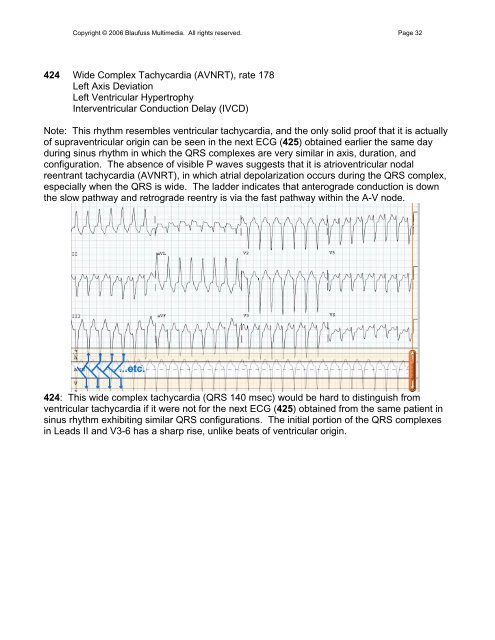002 Sinus Rhythm, atrial rate 90 Mobitz II - Blaufuss Multimedia
002 Sinus Rhythm, atrial rate 90 Mobitz II - Blaufuss Multimedia
002 Sinus Rhythm, atrial rate 90 Mobitz II - Blaufuss Multimedia
You also want an ePaper? Increase the reach of your titles
YUMPU automatically turns print PDFs into web optimized ePapers that Google loves.
Copyright © 2006 <strong>Blaufuss</strong> <strong>Multimedia</strong>. All rights reserved. Page 32<br />
424 Wide Complex Tachycardia (AVNRT), <strong>rate</strong> 178<br />
Left Axis Deviation<br />
Left Ventricular Hypertrophy<br />
Interventricular Conduction Delay (IVCD)<br />
Note: This rhythm resembles ventricular tachycardia, and the only solid proof that it is actually<br />
of supraventricular origin can be seen in the next ECG (425) obtained earlier the same day<br />
during sinus rhythm in which the QRS complexes are very similar in axis, duration, and<br />
configuration. The absence of visible P waves suggests that it is atrioventricular nodal<br />
reentrant tachycardia (AVNRT), in which <strong>atrial</strong> depolarization occurs during the QRS complex,<br />
especially when the QRS is wide. The ladder indicates that anterograde conduction is down<br />
the slow pathway and retrograde reentry is via the fast pathway within the A-V node.<br />
424: This wide complex tachycardia (QRS 140 msec) would be hard to distinguish from<br />
ventricular tachycardia if it were not for the next ECG (425) obtained from the same patient in<br />
sinus rhythm exhibiting similar QRS configurations. The initial portion of the QRS complexes<br />
in Leads <strong>II</strong> and V3-6 has a sharp rise, unlike beats of ventricular origin.


